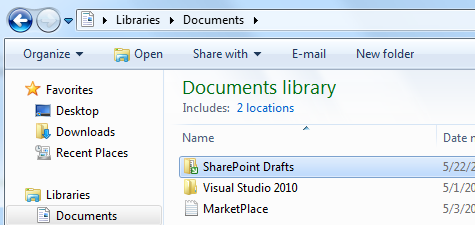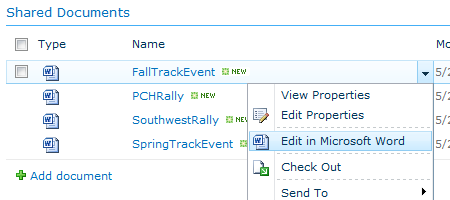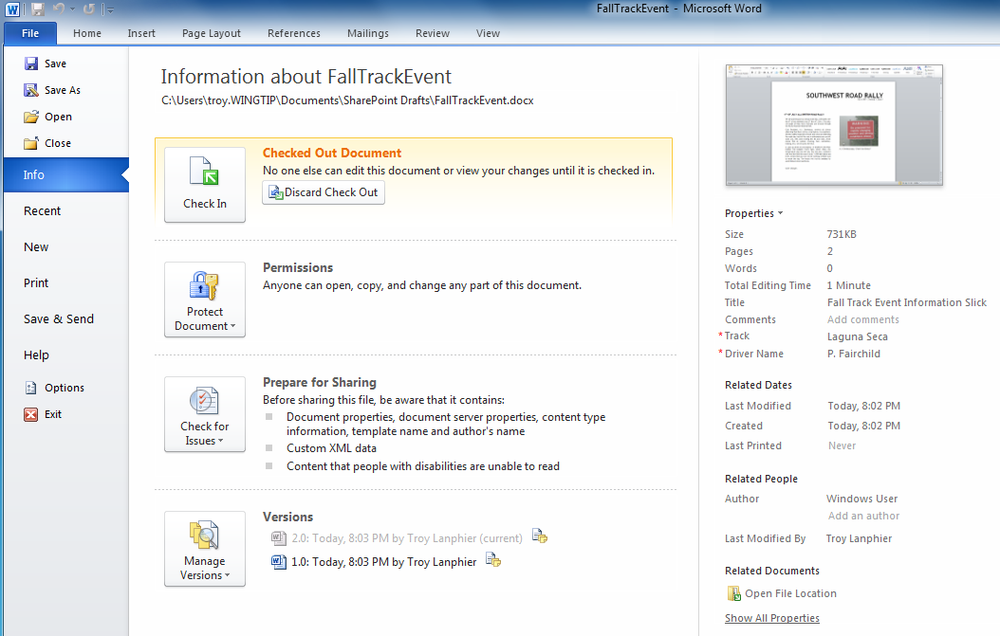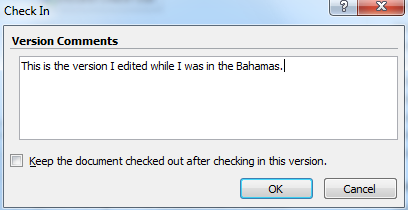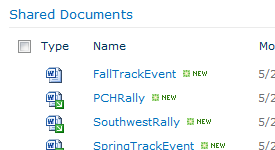As stated previously, there are several ways to take SharePoint content offline; the simplest mechanism is to use the local drafts folder (also referred to in some menus as the SharePoint Drafts folder. The process is easy and only requires that you 1) check out a document for editing from a document library, and 2) select the Use My Local Drafts Folder check box.
When you use this process to check out a document from its library, the original document is locked to prevent modification by any other user. A copy of the document is downloaded to the local file system where it can be altered. When the necessary alterations are complete, the document can again be uploaded to your SharePoint site and checked in for others to use.
The next few steps detail the process of taking a document offline by using the Check Out functionality. We begin by locating the document library that contains the document you want to edit. Hover your mouse over the file name to display the list item menu, and then select the Check Out menu item, as shown in Figure 12-31.
A dialog box appears, indicating the name and location of the document that you are checking out. Ensure that the Use My Local Drafts Folder check box is selected, and then click the OK button, as depicted in Figure 12-32.
Figure 12-32. Be sure to select the Use My Local Drafts Folder check box when checking out a document.
At this point, the original document is locked for editing (exclusively to you) and a copy is downloaded to your computer. If you have never checked out a file using this process, a new folder called SharePoint Drafts is created on your computer in your default Documents folder, as demonstrated in Figure 12-33.
Note
Unless this location has been changed by your Administrator, the default location of this folder is C:UsersyourusernameDocumentsSharePoint Drafts.
Figure 12-34 shows that opening the SharePoint Drafts folder in Windows Explorer displays all of the documents that are currently checked out to you.
Tip
INSIDE OUT Check-out required
Checking out a document in this manner is a very deliberate action; if a document library is not configured to require check-out for edits, you will not get a copy of the document in your local drafts folder when editing the document. The ability to use the local drafts folder is specifically dependent on the check-out mechanism found in SharePoint 2010.
When building a new document library, it is recommended that document check out be required for edits. This setting change is useful because people might want to be able to take versions of their files offline without having to explicitly choose Check Out first. If this setting is changed when the library is created, then a user can easily choose to store a copy of the document in their local drafts folder as part of the document edit process.
Tip
INSIDE OUT Enforcing check-out in a document library
If you happen to be the administrator of a document library, you can enforce check-out in a couple of steps. Open the document library, and then on the ribbon, on the Library tab, choose Library Settings | Versioning Settings. Under Require Check Out, select the Yes option, and then click OK.
To begin editing a document, open the document library. Hover your mouse over the item that you want to edit, and then select Edit In Microsoft Word in the list item menu that appears, as shown in Figure 12-35.
A dialog box appears (as shown in Figure 12-36), indicating the name and location of the document that you are checking out. Ensure that you select the Use My Local Drafts Folder check box, and then click the OK button.
At this point, the original document is locked for editing (exclusively to you) and a copy of it is downloaded to your computer. Anyone visiting the site while you have the file in a Checked Out status will see a green arrow on the icon for the file, as illustrated in Figure 12-37.
Now that you know how to obtain an offline copy of a document, let’s have a look at how SharePoint and Office 2010 keep track of the relationship between documents in a SharePoint Document Library and their counterparts on the local computer.
If Office 2010 has a document open that originated from a SharePoint site (whether your local computer is online or offline), the document knows what its relationship is to the server and what its status is.
Let’s see this functionality in action. When a local computer is connected to an intranet, an Office file has an active record of where it came from and its status. Select File, and then in the Backstage view, click the Info tab to view active information about the document. Particularly important are the following items (shown in Figure 12-38):
When the same computer goes offline (no connection to the network), the document status changes; specifically, as shown in Figure 12-39, the file’s Check In/Out button is gone, and its version status no longer matches the information presented when the computer is online.
The next order of business is to make your changes to the document and then reconnect it to the farm. You begin by opening the file, just as you would any other. Open your Office application, and then select File | Open. Browse to the SharePoint Drafts folder in your My Documents folder (see Figure 12-40).
Open the SharePoint Drafts folder, and then open the document that you want to edit by selecting it and choosing the Open button or by simply double-clicking it, as illustrated in Figure 12-41.
Make and save your edits to the document. Note that all changes are saved to the document in the SharePoint Drafts folder (Local Drafts).
When you reconnect to the network, you will see that the document Check In/Out status and Version status reappears in File Information. Now the document must be checked back in to the library so that others can see your edits. Be sure that you are connected to your network before proceeding to the next step.
Open the document as you did previously, and then select the File menu item. The Info tab should appear automatically, as shown in Figure 12-42.
Next, SharePoint gives you the opportunity to add comments to your new document version. In this example, you will not be leaving the document in a Checked Out state, so click the OK button to complete this step, as shown in Figure 12-43.
The document reappears on your screen (see Figure 12-44), indicating that it will require Check Out before being modified again.
Now, there is no longer a copy of this document being held in your local drafts folder, and it is safe to close your Office application. If you would like, you can also verify the document’s status by opening the document library and viewing the document’s status, as shown in Figure 12-45.



